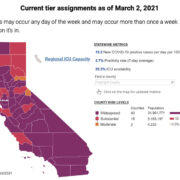
MARCH 11, 2020. Almost one year has passed since the World Health Organization (WHO) has declared the novel coronavirus (COVID-19) outbreak a global pandemic.
Many parts of the United States have been on lock-down and stay-at-home orders to mitigate the spread of COVID-19 and save lives, including California — home to the biggest population of Filipinos in the United States. It feels like a lifetime ago.
We recall how restrictions have been eased sometime in the summer last year, only to be enforced back again because of the surge of confirmed cases, hospitalization and death rate after the election and the holidays.
The good news is that since President Joe Biden took office, the federal government has commanded leadership in defeating the virus, and have used the power and resources of the Office of the President of the United States to save lives.
It is unfortunate that to date, as of press time, almost 521,000 have died of COVID in the United States , and there have been more than 29 million confirmed cases and counting.
The good news is that the trend of the number of confirmed cases, hospitalization rate and deaths have been on a decline in most parts of the country, prompting many counties to relax restrictions according to facts and actual data. Plus, Biden has announced that there will be enough supply of COVID-19 vaccines to cover every adult in America by the end of May.
This is so true in California as well. California, of course, with its mild weather, beautiful nature and plenty of opportunities is the biggest and more diverse state in the nation. It has the highest resident population in the United States in 2020, with 39.37 million people. Where there are more people, there will potentially be more infection rate in absolute numbers.
In December, Newsom announced a regional stay-at-home order, which imposed stricter restrictions on much of the state. According to covid19ca.gov: The CA Department of Public Health ended the Regional Stay Home Order across California. This action came as projected ICU availability rose above 15%. Counties have returned to their assigned Blueprint tiers and are urged to continue safe practices, avoiding crowds and wearing a mask when leaving home. The stay-at-home orders were all lifted on January 25.
In case you are not familiar with the tiers used in the state’s determination to ease restrictions in different counties, here they are as reported by ABC News:
“With the stay-at-home orders lifted, the state is returning to the four-tier reopening system. The four tiers are yellow, orange, red and purple. Yellow indicates minimal COVID-19 spread and allows for nearly all businesses to reopen indoor operations (as long as physical distancing and face-covering requirements are in place). Purple means there is widespread COVID-19 transmission in the county and nearly all businesses have to keep indoor operations closed or severely limited.”
California counties that are now downgraded from the blue (stay-at-home) to purple (most restrictions after blue tier) are now down to the less restrictive red tier include:
Northern California:
Del Norte, Modoc, Humboldt, Trinity, Shasta, Lassen’ Plumas (Sierra is in orange tier)
San Francisco Bay Area and Sacramento:
Napa, Yolo, Sacramento, El Dorado, San Francisco, San Mateo, Santa Clara
Central:
Mariposa, San Luis Obispo, (Alpine in orange tier)
All counties of Southern California, however, remain in purple tier. Unfortunately, many counties in Southern California are among the Top 10 counties that have the greatest number of cases in the United States, as reported by the John Hopkins University as of Friday noon, March 5.
1. Los Angeles – 1,198,178 confirmed
2. Maricopa – 513,035 confirmed
3. Cook – 476,835 confirmed
4. Miami-Dade – 416,021 confirmed
5. Harris – 356,429 confirmed
6. Riverside – 290,744 confirmed
7. San Bernardino – 287,246 confirmed
8. Dallas – 283,180 confirmed
9. Orange – 261,976 confirmed
10. San Diego – 261,861 confirmed
We hope all counties would ease more restrictions now that Gov. Gavin Newsom and will all be on the way to normalcy.
How do we do it together? Huwag pasaway!
Stay home except for essential needs.
Wear a mask in public.
Wash your hands regularly.
Keep at least six feet of physical distance when in public.
Limit mixing with people you don’t live with.
Get vaccinated.
* * *
The opinions, beliefs and viewpoints expressed by the author do not necessarily reflect the opinions, beliefs and viewpoints of the Asian Journal, its management, editorial board and staff.
* * *
Gel Santos Relos has been in news, talk, public service and educational broadcasting since 1989 with ABS-CBN and is now serving the Filipino audience using different platforms, including digital broadcasting, and print, and is working on a new public service program for the community. You may contact her through email at gelrelos@icloud.com, or send her a message via Facebook at Facebook.com/Gel.Santos.Relos.





